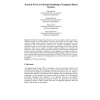973 search results - page 108 / 195 » Arguing Using Opponent Models |
SIGMETRICS
2008
ACM
13 years 7 months ago
2008
ACM
Although recent advances in theory indicate that burstiness in the service time process can be handled effectively by queueing models (e.g., MAP queueing networks [2]), there is a...
JUCS
2000
13 years 7 months ago
2000
: Embedded Computer-based Systems are becoming highly complex and hard to implement because of the large number of concerns the designers have to address. These systems are tightly...
ISCA
2010
IEEE
14 years 18 days ago
2010
IEEE
Given the multicore microprocessor revolution, we argue that the architecture research community needs a dramatic increase in simulation capacity. We believe FPGA Architecture Mod...
ER
2010
Springer
13 years 6 months ago
2010
Springer
Abstract. We demonstrate the manner in which high-level design requirements, e.g., as they correspond to the commonsensical conceptualisation of expert designers, may be formally s...
ASPLOS
2010
ACM
14 years 18 days ago
2010
ACM
Heterogeneous computing combines general purpose CPUs with accelerators to efficiently execute both sequential control-intensive and data-parallel phases of applications. Existin...

